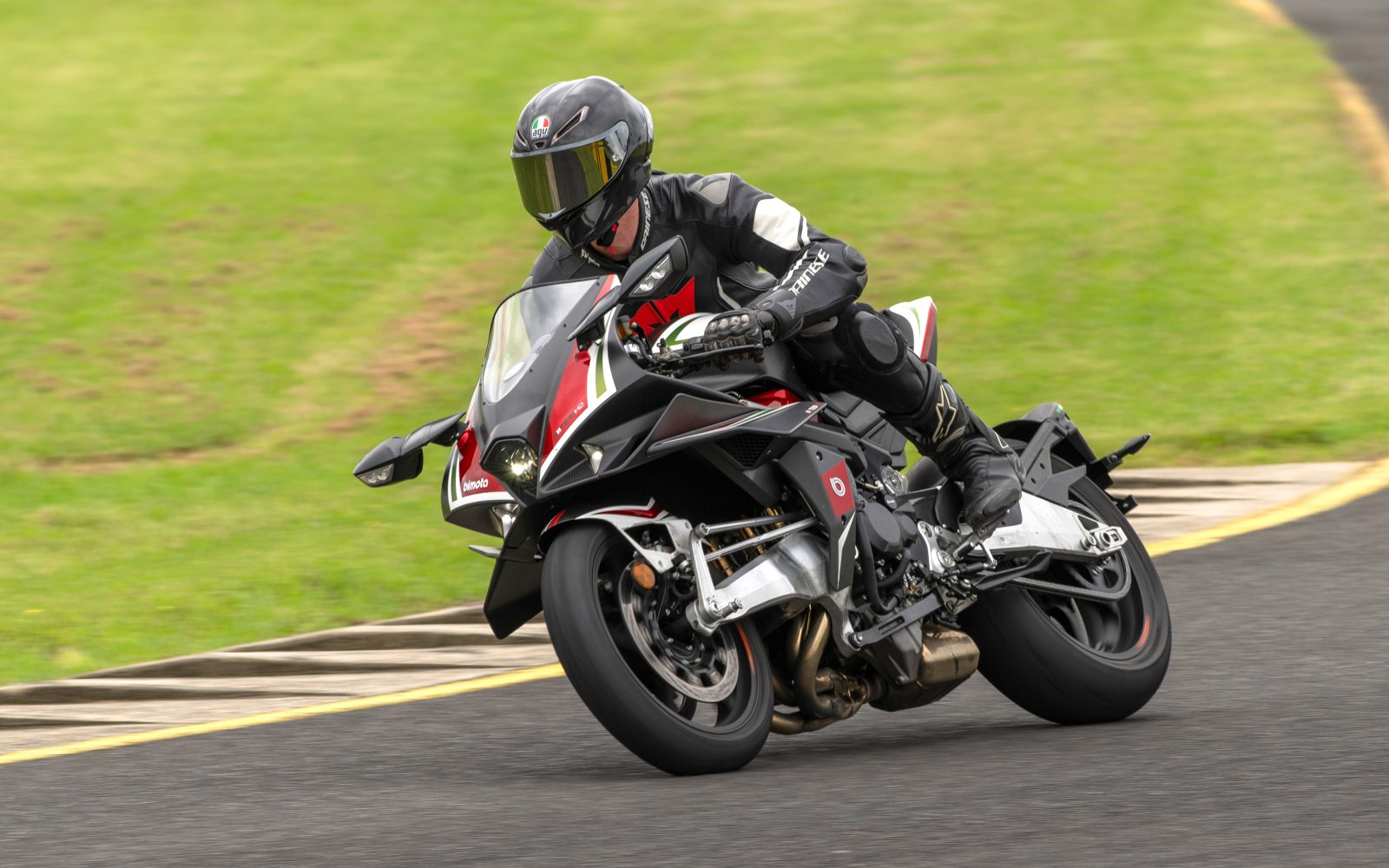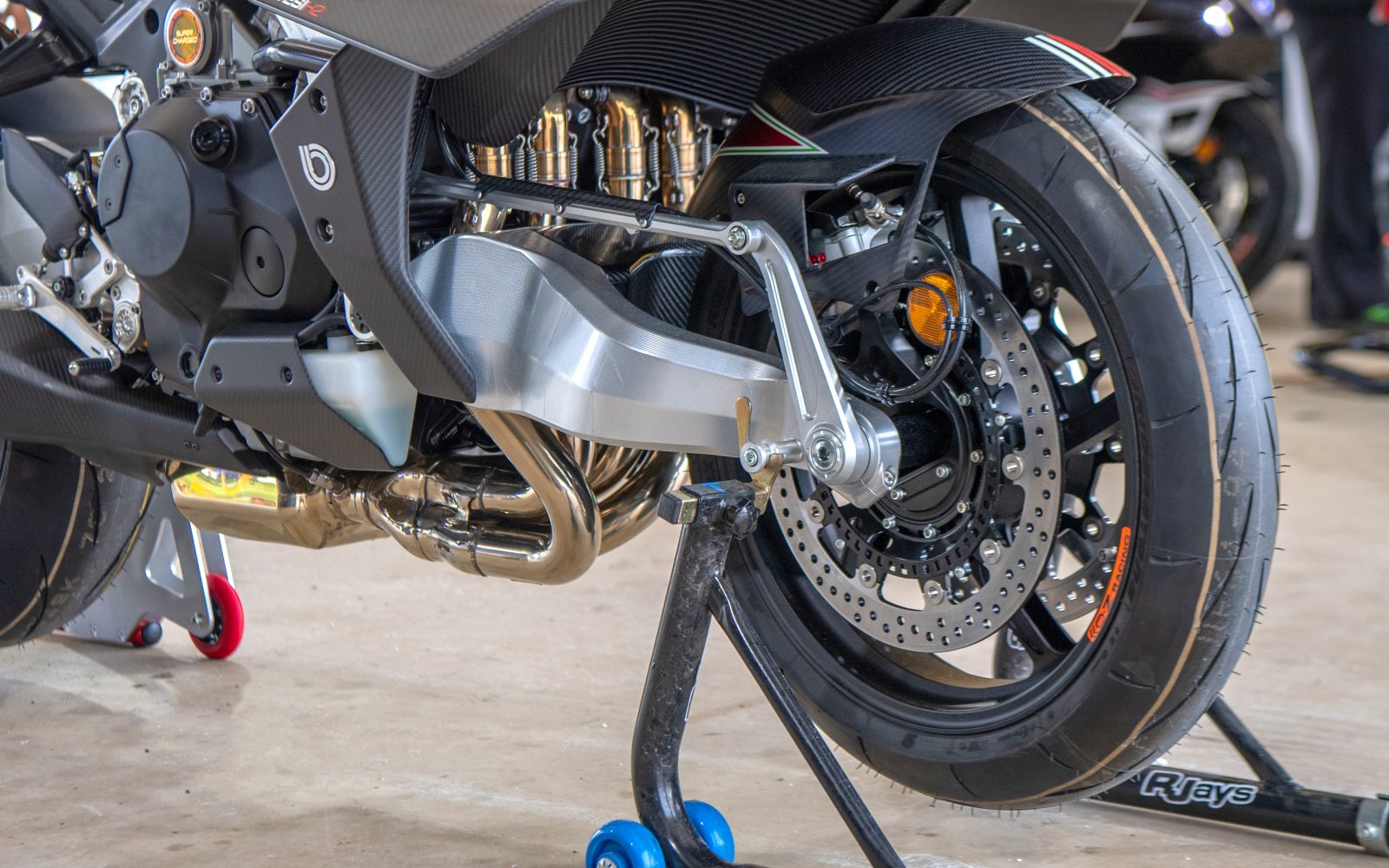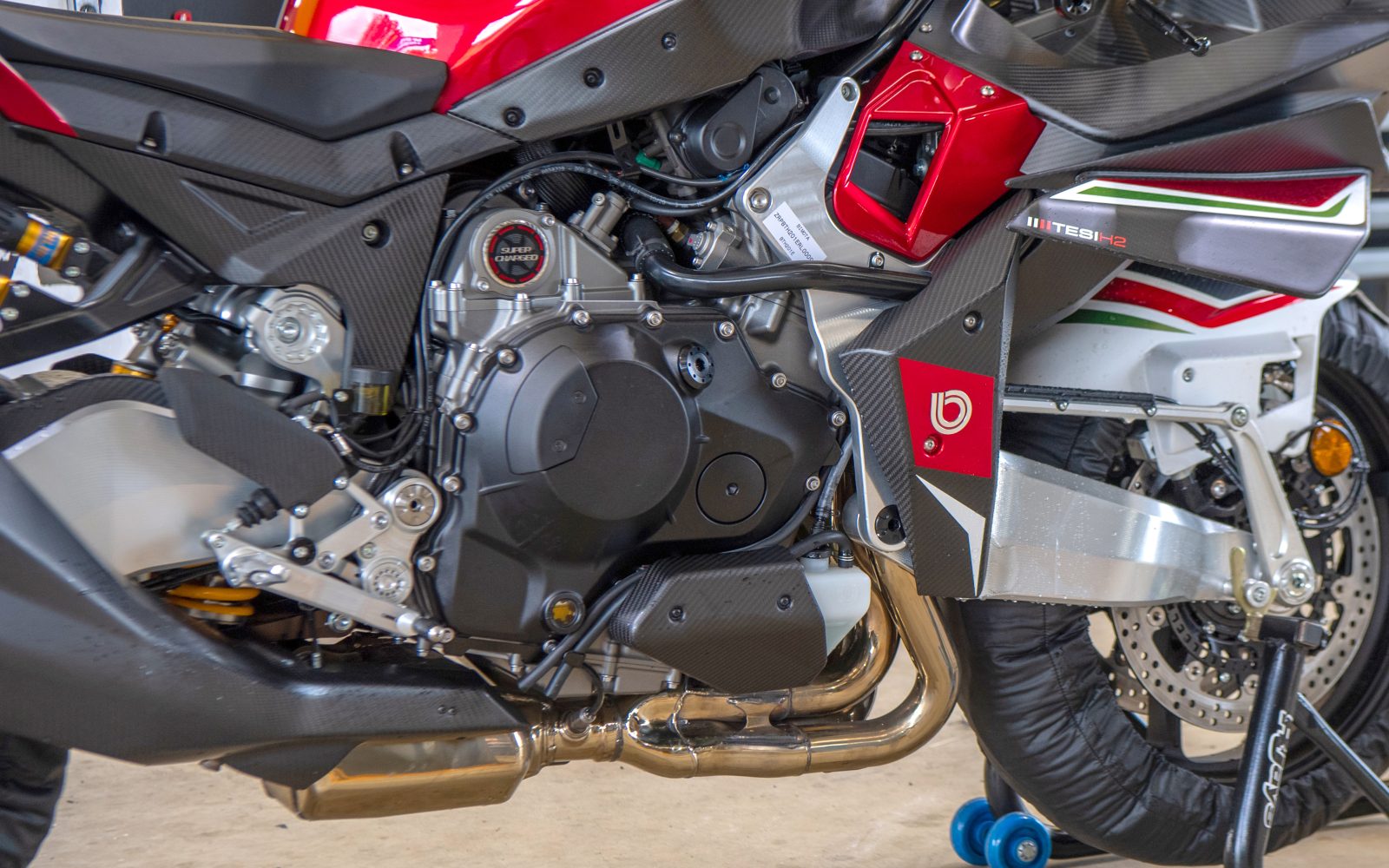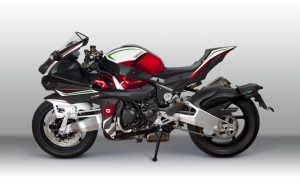I don’t know about you, but my earliest Bimota memory is from the 1990s, when the Tesi 1D first materialised. To a young bloke tooling around on an old Guzzi, it felt like it had arrived from another models to arrive on our shores, as it has been four years since Kawasaki agreed to share components and access to its worldwide dealer network with Bimota. But the covers eventually came off the new KB4 ($55,000) and Tesi H2 ($85,000) models at Sydney-based dealership Procycles late last year.
What struck me at the time was how the latest Tesi H2 still manages to look futuristic and sexier than the bike it’s based on (the Ninja H2). That’s certainly thanks to all the sharp angles and carbon fibre, but mostly it’s the hub-centre steering that somehow continues to look like it’s from a galaxy far, far away, despite the concept being more than a century old. And just to mess with everyone’s heads, its less-expensive sibling, the KB4 (based on the Ninja 1000SX) looks very retro, despite being thoroughly modern.

The first opportunity to test both bikes in Australia came at Sydney Motorsport Park a few weeks later. We were given private access to the Amaroo South Circuit for an afternoon. Its short (1.8km), highly technical layout includes a series of tight, close corners, including a downhill lefthand hairpin. There’s no straight to speak of, so it’s a matter of hard acceleration and hard braking in short bursts, and a lot of movement on the bike. It is a testing circuit for any motorcycle, never mind big-bore exotica, especially when it’s damp.
I had three sessions on each bike. The first few were a bit wet following a rainy morning but the track dried out quite quickly thanks to a stiff breeze and the summer heat. My first session was on the KB4. Despite the wet track, I felt at home on it from the start. It’s very much a traditional motorcycle by Bimota standards, with its conventional (but fully adjustable) fork, but it just wouldn’t be a Bimota without some special chassis construction. The front trellis that supports the fork is mounted directly to the engine, while at the rear a machined aluminium pivot plate is used to mount the swingarm. The result is a short wheelbase akin to that of a 600cc bike. (The KB4’s wheelbase is 1390mm while the Ninja ZX-6R’s is 1400mm and a stock Ninja 1000SX’s is 1440mm.) Furthermore, its under-seat radiator system allows the engine to be positioned farther forward resulting in what Bimota believes to be an almost ideal front-rear weight distribution.

All this was immediately noticeable on the tight, tricky track. It does indeed feel like a smaller bike than it is, and it took no time at all to be braking heavily into corners and accelerating hard out of them, gaining confidence in grip and handling.
The seating position is surprisingly comfortable while still feeling sporty. The footpeg position and ride height can be adjusted and, of course, there’s the fully adjustable front and rear Öhlins suspension. But the bike felt well set-up from the start, especially for a few short sessions on the track, so I left it unchanged and focused on getting to know the machine.
The KB4’s 1043cc inline four-cylinder engine comes straight from the Ninja 1000SX and is combined with all the Kawasaki electronics you’d expect in a premium package. The power delivery is strong, linear and well suited to the bike. My feeling is that the engine note is overly restricted by those big gold pipes, so new owners would probably go for an aftermarket system.
This would also help alleviate an unexpected ground clearance issue, as the carbon fibre exhaust cover touched the tarmac a few times before the right footpeg had a chance to warn me. Saying that, I can’t imagine this bike will see much track time with most owners – it’s natural habitat would be mountain twisties on a sunny day, where I know it would be an absolute hoot.

Changing over to the Tesi H2 involved a complete brain recalibration. Getting to grips with an expensive carbon-fibre-clad supercharged machine with a hub-centre-steering system on a wet track was a bit of a head spin. Not that it wasn’t enjoyable, and by the final dry sessions I was feeling much more comfortable on it, although never in the way that the KB4 felt natural from the word go.
I found the seating position a little cramped for my 190cm frame, but the angular tank proved great to dig the knees into. This helped take a bit of weight off the wrists on what is definitely an aggressive riding position.
The 998cc inline four-cylinder supercharged engine that powers the Tesi H2 is of course from the formidable Ninja H2. This famous powerplant produces maximum power of 170kW (228hp) at 11,500rpm and maximum torque of 141.7Nm at 11,000rpm. Not that I needed anywhere near all of that. All I could think while riding the Tesi H2 was how much I would love to open it up down the straight on the full circuit. It is a bike that cries out for long straights and sweeping open corners.

I was surprised to discover that the Tesi H2 wasn’t that unusual in terms of handling, grip and feel. The anticipated weirdness of the front end never really eventuated, but you can feel how the unctions of braking, suspension and steering are essentially separated by the bike’s unique design. It’s different and takes some getting used to, but it’s not unnerving or vague, and I feel that more time with this machine would help me harness the positives of this system.
What was particularly noticeable was that under heavy braking, especially downhill, the bike didn’t really dive at all, allowing the impressive and effective Brembo stoppers to do their thing. In fact, I found myself over-braking on numerous occasions, not realising how quickly speed could be washed off.
What did feel strange had nothing to do with Bimota’s chassis trickery. The power delivery at low speed is extremely abrupt, making acceleration out of low-speed corners a tricky affair. No matter how gentle I was in winding it back on, the power punch was excessive on delicate exits. I was glad to have the suite of rider aids as a back-up for a heavy wrist, but this issue would be even more troublesome on the patchy surfaces of the real world. It turns out that it is a known issue courtesy of European emission restrictions and can be rectified with some clever tuning. But it was definitely disconcerting powering out of a slippery hairpin with what felt like an on-off button attached to a supercharger.

Speaking of which, I love the sound of the chirping supercharger spinning away, but again those big pipes mute the engine note more than I’d like. As luck would have it, an easy-to-fit, lightweight full titanium exhaust system is included in the price of the Tesi H2. I suspect that fitting that would be the first thing a new owner would do to the bike, in combination with engine electronics tuning. Again, my guess is that most of these bikes won’t be taken to the track at all, and I’d love to get my hands on a Tesi for a few days of spirited road riding on my favourite roads.
It would be interesting to see how the exotic set-up handled Aussie road conditions. My guess is surprisingly well, although you’d definitely be in danger of losing your licence with all that power. I came away from the track feeling that if I had $85,000 to spare and was in the market for a Bimota, I’d still probably go for the KB4 for everyday use and pure fun. Then I’d use the $30,000 difference between the two to buy a very decent daily ride.
However, there’s no doubt that the Tesi H2 is a stunningly unique machine. If money was no object, perhaps buying both the KB4 and the Tesi H2 and hitting the track with each on occasion wouldn’t be the worst way to spend $140,000. One can only dream…
TEST: SEAN MOONEY PHOTOGRAPHY: HALF LIGHT PHOTOGRAPHY
Teshi H2

ENGINE
Capacity 998cc
Type Supercharged inline-four, four valves per cylinder
Bore & stroke 76 x 55mm
Compression ratio 8.5:1
Cooling Liquid
Fueling EFI, 4 x 50mm throttle bodies
Transmission Six-speed
Clutch Wet, multi-plate, slipper
Final drive Chain
PERFORMANCE
Power 170kW @ 11,500rpm (claimed)
Torque 104.5Nm @ 11,000rpm (claimed)
Top speed 300km/h (est)
Fuel consumption Not measured
ELECTRONICS
Type Mitsubishi ECU/Bosch
Rider aids Cornering ABS, Cornering Traction Control, Launch Control, Cruise Control
Rider modes Track, Sport, Rain & Rider
CHASSIS
Frame material Aluminium alloy
Frame type Billet-machined plates
Rake 21.3°
Trail 117mm
Wheelbase 1445mm
SUSPENSION
Type Öhlins
Front: Billet aluminium alloy swingarm, TTX36 monoshock, 110mm travel
Rear: Billet aluminium alloy swingarm, TTX36 monoshock, 130mm travel
WHEELS & BRAKES
Wheels Oz Racing, forged
Front: 17 x 3.5 Rear: 17 x 6.0
Tyres Bridgestone RS11
Front: 120/70ZR17
Rear: 200/55ZR17
Brakes Brembo, ABS
Front: Twin 330mm disc, four-piston Stylema caliper
Rear: Single 220mm disc, twin-piston caliper
DIMENSIONS
Weight 207kg (dry, claimed)
Seat height 840mm
Width 770mm
Height 1155mm
Length 2074mm
Ground clearance 140mm
Fuel capacity 17L
SERVICING & WARRANTY
Servicing First: 1000km
Minor: 12,000km
Major: 24,000km
Warranty Two years, unlimited km
BUSINESS END
Price $85,000 (ride away)
Colour options Tricolore or Carbon
Pros: Supercharged engine, technically intriguing hub-centre-steering, fab rider aids and loads of carbon fibre.
Cons: Abrupt low-speed power delivery, stock exhaust is huge (but included titanium exhaust fixes that) and it’s expensive.
CONTACT: www.facebook.com/bimotaau
KB4

ENGINE
Capacity 1043cc
Type Inline four, DOHC, 16-valves
Bore & stroke 77 x 56mm
Compression ratio 11.8:1
Cooling Liquid
Fueling EFI, 4 x 38mm throttle bodies
Transmission Six-speed
Clutch Wet, multi-plate, slipper
Final drive Chain
PERFORMANCE
Power 104.5kW @ 10,000rpm (claimed)
Torque 111Nm @ 8000rpm (claimed)
Top speed 285km/h (est)
Fuel consumption Not measured
ELECTRONICS
Type Mitsubishi ECU, Continental ABS, Ride-by-wire
Rider aids Cornering ABS, Traction Control, Cruise Control
Rider modes Sport, Road, Rain and Rider
CHASSIS
Frame material Chrome-moly tubular steel
Frame type Trellis
Rake 24°
Trail 100.8mm
Wheelbase 1390mm
SUSPENSION
Type Öhlins
Front: 43mm USD NIX30 fork, fully-adjustable, 130mm travel
Rear: TTX36 twin-tube monoshock, fully-adjustable, 122mm travel
WHEELS & BRAKES
Wheels Forged alloy
Front: 17 x 3.5 Rear: 17 x 6.0
Tyres Pirelli Diablo Supercorsa Evo
Front: 120/70ZR17
Rear: 190/50ZR17
Brakes Brembo, ABS
Front: Twin 320mm disc, four-piston Stylema caliper
Rear: Single 220mm disc, twin-piston caliper
DIMENSIONS
Weight 194kg (kerb, claimed)
Seat height 810mm
Width 774mm
Height 1150mm
Length 2050mm
Ground clearance 140mm
Fuel capacity 19.5L
SERVICING & WARRANTY
Servicing First: 1000km
Minor: 12,000km
Major: 24,000km
Warranty Two years,unlimited km
BUSINESS END
Price $55,000 (ride away)
Colour options Red/Wht/Gold
Pros: Short wheelbase, easy to ride at any speed, excellent rider aids and retro good looks.
Cons: Ground clearance with standard exhaust and hard to justify the cost over similarly capable but cheaper competition.
CONTACT: www.facebook.com/bimotaau











